

Agelastic/eudyptula: www.eudyptula-challenge.org. Welcome to The Linux Kernel’s documentation. Linux source code (v5.10.13) - Bootlin. Browse. Write and Submit your first Linux kernel Patch. Linux Kernel Teaching — The Linux Kernel documentation. Explorons le noyau Linux. Sources officielles Les versions officielles du noyau Linux sont téléchargeables depuis La page d'accueil permet un accès rapide à : La version stable actuelle (stable)La version en cours de développement (mainline)Les versions plus anciennes encore maintenues (longterm) Note : le cycle de développement et de support du noyau sera étudié plus tard dans le cours.
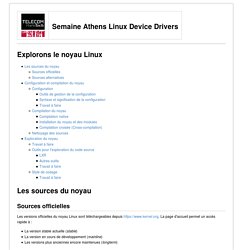
Les sources peuvent être récupérées sous forme d'une archive contenant une version donnée (format .tar.xz). Une fois décompressées, les sources d'une version prennent près de 900 Mio (887 Mio pour la version 4.13.9 lors de l'écriture de cette page). Il est également possible (et même conseillé si on veut développer), de récupérer directement le dépôt git officiel incluant tout l'historique (depuis que les développeurs du noyau utilisent git !) $ git clone ou bien (par exemple si un pare-feu paranoïaque bloque l'accès au protocole git (port TCP 9418)) : $ git clone En août 2018, une copie du dépôt git officiel prend environ 2,1 Gio.
Publication d'un guide sur la contribution au noyau Linux par la Linux Foundation. La Linux Foundation a publié récemment un guide intitulé How To Participate In the Linux Community, rédigé par Jonathan Corbet, l'un des principaux éditeurs du site Linux Weekly News et co-auteur du livre Linux Device Drivers.
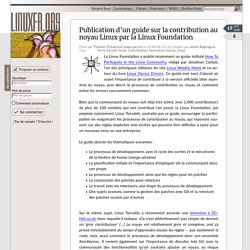
Ce guide met tout d'abord en avant l'importance de contribuer à la version officielle (dite mainline) du noyau, puis décrit le processus de contribution au noyau et comment éviter les erreurs couramment commises. Bien que la communauté du noyau soit déjà très active, avec 1.000 contributeurs de plus de 100 sociétés qui ont contribué l'an passé, la Linux Foundation, qui emploie notamment Linus Torvalds, souhaite par ce guide, encourager la participation en vulgarisant les processus de contribution au noyau, qui reposent souvent sur des règles implicites non-écrites qui peuvent être difficiles à saisir pour un nouveau venu ou une entreprise.
Le guide aborde les thématiques suivantes : Comment devenir un kernel hacker ? Linux Device Drivers, Third Edition. This is the web site for the Third Edition of Linux Device Drivers, by Jonathan Corbet, Alessandro Rubini, and Greg Kroah-Hartman.
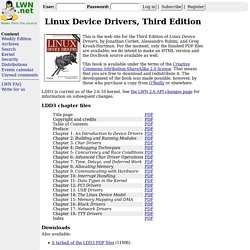
For the moment, only the finished PDF files are available; we do intend to make an HTML version and the DocBook source available as well. This book is available under the terms of the Creative Commons Attribution-ShareAlike 2.0 license. That means that you are free to download and redistribute it. The development of the book was made possible, however, by those who purchase a copy from O'Reilly or elsewhere. LDD3 is current as of the 2.6.10 kernel. LDD3 chapter files Downloads Also available: A tarball of the LDD3 PDF files (11MB). Hacking Guides. Anatomy of the Linux kernel – IBM Developer. Given that the goal of this article is to introduce you to the Linux kernel and explore its architecture and major components, let’s start with a short tour of Linux kernel history, then look at the Linux kernel architecture from 30,000 feet, and, finally, examine its major subsystems.
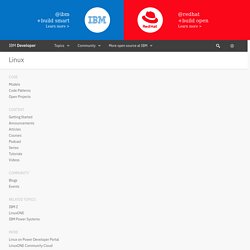
The Linux kernel is over six million lines of code, so this introduction is not exhaustive. Use the pointers to more content to dig in further. A short tour of Linux history Linux or GNU/Linux? You’ve probably noticed that Linux as an operating system is referred to in some cases as “Linux” and in others as “GNU/Linux.” While Linux is arguably the most popular open source operating system, its history is actually quite short considering the timeline of operating systems. In the 1960s, Massachusetts Institute of Technology (MIT) and a host of companies developed an experimental operating system called Multics (or Multiplexed Information and Computing Service) for the GE-645. Figure 1. Figure 2. Figure 3. Understanding Linux Kernel. Linux Directory Structure (File System Structure) Explained with Examples. By Ramesh Natarajan on September 8, 2010 Have you wondered why certain programs are located under /bin, or /sbin, or /usr/bin, or /usr/sbin?
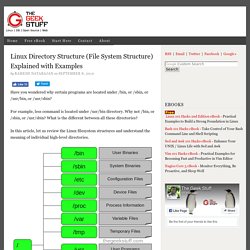
For example, less command is located under /usr/bin directory. Why not /bin, or /sbin, or /usr/sbin? What is the different between all these directories? In this article, let us review the Linux filesystem structures and understand the meaning of individual high-level directories. 1. / – Root Every single file and directory starts from the root directory.Only root user has write privilege under this directory.Please note that /root is root user’s home directory, which is not same as /. 2. Contains binary executables.Common linux commands you need to use in single-user modes are located under this directory.Commands used by all the users of the system are located here.For example: ps, ls, ping, grep, cp. 3. 4. 5.
Interactive map of Linux kernel. How Participate Linux Community 0. Linux_Kernel_Newbies. Steps for contributing to the Linux Kernel. One of the biggest—and the fastest moving—open source projects, the Linux kernel, is composed of about 53,600 files and nearly 20-million lines of code.
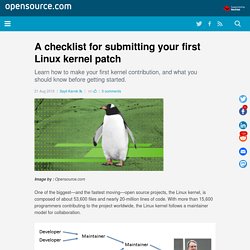
With more than 15,600 programmers contributing to the project worldwide, the Linux kernel follows a maintainer model for collaboration. In this article, I'll provide a quick checklist of steps involved with making your first kernel contribution, and look at what you should know before submitting a patch. For a more in-depth look at the submission process for contributing your first patch, read the KernelNewbies First Kernel Patch tutorial. Contributing to the kernel Step 1: Prepare your system. Steps in this article assume you have the following tools on your system: